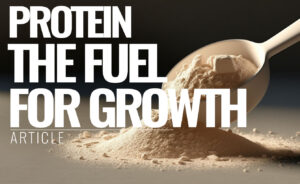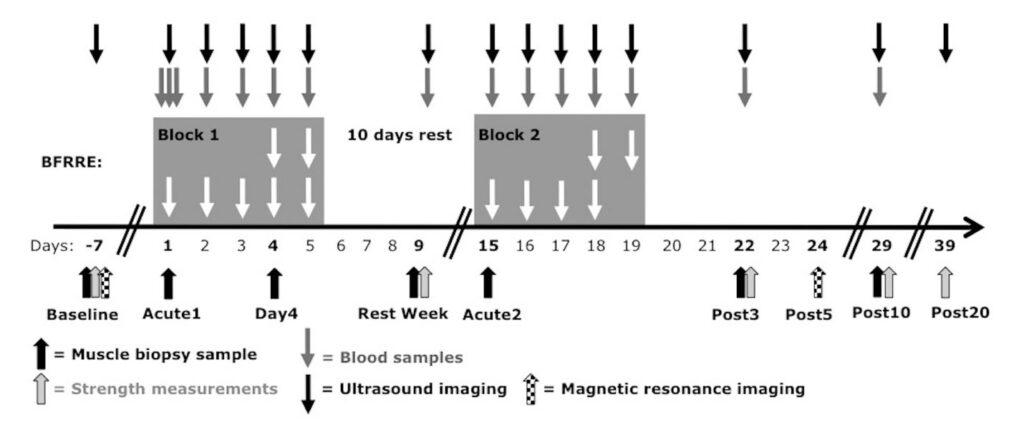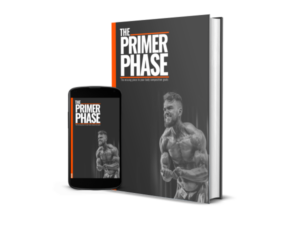
Revive Stronger
Overreaching for Muscle Hypertrophy: The potential benefit of a short-term higher-volume phase

Overreaching phases are often seen in single-event sports such as powerlifting and track and field. In the simplest of terms, an overreaching phase is based on the fitness-fatigue model. When you’re recovered, you are going to have a high-level of fitness and low-level of fatigue – leading to a high level of performance. When you train, the session is going to impose a stress on the body which is going to decrease fitness and increase fatigue. Then, you must allow your body to recover and adapt. During the adaptation process, your body will reach a higher level of fitness while fatigue returns to normal.
The goal of an overreaching phase is to impose a very large amount of stress in your body through training and then immediately enter a recovery phase. The purpose is to briefly exceed your recovery capacity and then obtain a greater super-compensation than normal when you recover.
While powerlifters and sprinters have been using this method of periodization for decades, it really hasn’t had much translation to bodybuilding… so far. If you think about it, bodybuilders don’t need to peak their performance for a physical feat. Bodybuilders need to accumulate training volume over time, so lifting very high loads and then backing off training to recover probably does not have the greatest benefit to bodybuilding. However, three new studies have come out that have led me to rethink the efficacy of short, high-volume phases in bodybuilding.
Table of Contents
Bjornsen et al. (2019)
Up until this study, there was no real evidence of supercompensation for hypertrophy. In this study, 16 participants underwent two 1-week training blocks of blood-flow restriction training, with 10-days of rest in between. The sessions within the training blocks were done with a high frequency, as 7 sessions were performed in 5 days in each block.

The protocol itself consisted of 4 sets of knee extensions at 20% of 1RM, with 30s rest between sets. The cuff was kept on from the first set to the fourth set and released immediately after the fourth set was completed. On average 51±9,13±4, 11±4, and 10±4 repetitions were performed in the first, second, third, and fourth set, respectively. Thus, it is safe to say this protocol was very intensive. In fact, two people dropped out of the study with blood markers that reflected some serious overtraining.
Muscle biopsies were obtained 1-hour after the first session on each day of the block (Acute 1 and Acute 2). Additionally, biopsies were obtained after the 4th day of the first block (Day4), 3-days after the second block (Post3) and 10-days after the first block (Post10)
Here is where this paper gets interesting: both Type I and Type II muscles fibres decreased in size from baseline to Day 4 by 6% and 15%, respectively. Then, 10 days after the second-block was over, it was shown that both Type I and Type II muscles fibres increased in size by 19% and 11%, respectively. This gave a clear insight that hypertrophy may have a delayed response after a high-volume training protocol.
Additionally, there were no changes in myonuclei from baseline to the end of the first block. However, Type I fibre myonuclei number increased at Post3 and Post10 by 21 ± 17 and 30 ± 24%, respectively. Type II fibre myonuclei number increased at Post3 and Post10 by 19 ± 18 and 31 ± 27%, respectively. This portion of the paper showed delayed myonuclear addition for the first time.
In short, this study found the first evidence that a short-term overreaching phase can result in a short term “exhaustion” phase that may lead to a super compensation effect.
Haun et al. (2019)
Until now, sarcoplasmic hypertrophy was always thought to occur in proportion to myofibrillar hypertrophy. The general consensus has been that sarcoplasmic hypertrophy cannot happen independently of myofibrillar hypertrophy. In this paper, participants followed the training program below for 6 weeks.
| Day 1 | Day 2 | Day 3 |
| BB Back Squat BB Bench Press BB Stiff Legged Deadlift Machine Undergrip Pulldown | BB Back Squat BB Overhead Press BB Stiff Legged Deadlift Lat Pulldown | BB Back Squat BB Bench Press BB Stiff Legged Deadlift Machine Undergrip Pulldown |
They started the training program by doing 10 sets per week per exercise and ended with 32 sets per exercise by the end of the 6 weeks. The exercises were performed with 60% of 1RM for 10 reps.
Biopsies for the vastus lateralis were obtained and analyzed prior to beginning the program and at Week 6. A few subjects also gave biopsies at Week 7 to determine what happened after deloading.
The authors found a couple of very interesting things:
- Muscle fiber cross-sectional area (fCSA) increased by 24% from PRE to Week 6
- Myosin and actin decreased by 30% from PRE to Week 6
- Sarcoplasmic proteins increased from PRE to Week 7
- Proteins involved in glycolysis and metabolic processes for ATP production were elevated.

Since muscle fCSA increased while contractile proteins decreased and sarcoplasmic proteins increased, we have evidence that suggests that the initial gains in muscle fibre size were due to sarcoplasmic hypertrophy – rather than myofibrillar hypertrophy.
It is hypothesized that sarcoplasmic hypertrophy occurred in this very high-volume program in order to spatially prime cells for increases in myofibrillar protein and for the increase in metabolic enzymes.
Enzymes required for energy production could have been upregulated for two reasons
- To support the highly energy expensive myofibrillar protein synthesis that was about to follow
- To adapt to the energy demands of the high-volume program.
Importantly, this paper showed an increase in sarcoplasmic protein independent of changes in myofibrillar hypertrophy and has certainly raised many questions about sarcoplasmic hypertrophy.
In short: It was found that sarcoplasmic protein content increased from PRE to Week 7. An increase in proteins involved in glycolysis and metabolic processes for ATP generation was also observed. Thus, it is likely that the sarcoplasmic expansion happened in order to allow for the metabolic demands of the very-high volume training
Schoenfeld et al. (2019)
Schoenfeld and colleagues aimed to find an upper limit to training volume, where increases in volume no longer lead to increases in muscle hypertrophy.
In a seminal meta-analysis, Schoenfeld et al. (2017) showed that performing at least 10 sets per muscle group per week led to significantly greater muscle gain than <5 weekly sets and 5-9 weekly sets. The authors suspected an upper limit to volume, where increasing volume would no longer lead to greater hypertrophy. However, there was no clear evidence to suggest where this point might be.
In a recent paper by Schoenfeld et al. (2019), well-trained males were split into three groups. The groups did either one, three or five sets per exercise in a three-day per week full-body program, which led to 6-9, 18-27 or 30-45 weekly sets. All sets were taken to failure and performed in the 8-12 rep range.
It’s important to note that the top of the weekly set range was not reached through isolation movements. The subjects did not actually perform 9, 27 or 45-set isolation sets in their respective muscle groups. A set of a compound movement was counted as a set for all the individual muscles that it involves. I.e., one would count a bench press as one set for the chest, shoulders and triceps. Therefore, body parts such as the biceps and triceps that are involved in many compound movements accumulated a large number of weekly sets. The authors recorded pre- and post- bench press 1-RM, bench press muscular endurance, and muscle thickness of the biceps, triceps, vastus lateralis and rectus femoris.
In this paper, they did not find an upper limit for the relationship between volume and hypertrophy. Rather, they saw a dose-response relationship between volume and hypertrophy that persisted even in the higher ranges of volume. By this, I mean that the group that did 30-45 sets gained more muscle thickness than the group that did 18-27 sets, who gained more muscle thickness than the group that did 6-9 sets. Interestingly, they saw no differences in muscle strength or endurance between groups.
Now, this study does not mean that you should do endless volume. It is very likely that this upper limit exists around the 15-20 set range for most people. However, you could use higher volumes (within reason) for a short period of time, such as a brief overreaching phase. Additionally, you could temporarily increase training volume for a lagging body part to see if this allows you to break the plateau. If you choose to briefly increase volume by adding more sets than usual, you must pay close attention to recovery cues (performance, soreness, sleep disturbances, irritability, achiness, etc.) to determine whether this volume is appropriate, even for the short term.
Conclusion
Overreaching for Muscle Hypertrophy
The reason that I am discussing these 3 papers is that they all show one thing in common – a benefit to a brief higher-volume training phase. Now, I do not think the amount of training volume used in these papers is sustainable over a long period of time and do not recommend that you train beyond your capacity to recover over a long period of time.
To summarize, these papers found the following three things:
- A delayed hypertrophic response and myonuclear addition after a period of high volume training
- Sarcoplasmic hypertrophy in response to very high volume training
- A dose-response relationship between volume and hypertrophy where an upper limit was not well defined
Put together, these results suggest that short-term very-high volume training is likely beneficial for promoting hypertrophy.
Practical Application
Based on the data that we have, I believe that to get the most out of a hypertrophic overreaching phase, we need to briefly increase the number of sets being performed but also use loads and other techniques that will allow you tax the glycolytic system.
Adding Sets
Maximum Recoverable Volume (MRV) is the most amount of training volume that you can perform and still recover/benefit from. For most people reading this, it will likely be around 10-20 sets per muscle group per week, assuming you are training progressively and coming close to failure with each set.
An overreaching phase can likely be performed by briefly adding in more sets than you would typically be able to recover from. However, you don’t want to add so many sets that you get injured or start performing junk volume. It is my speculation that adding 3-4 sets taken near failure would likely allow you to enter an overreaching phase. For example, if you usually train your chest with 12-15 sets within an accumulation block, you could try briefly training with 15-19 sets.
Taxing the Glycolytic System
While we certainly need more research on sarcoplasmic hypertrophy, it would seem that it largely happens in order to adapt to the energy demands of training that heavily relies on the glycolytic system. Thus, it would probably not be a good idea to add in sets of 3 heavy reps on the squat.
If we operate under the assumption that sarcoplasmic hypertrophy is possible, then we should probably train in a way that will demand lots from anaerobic glycolysis. This would likely involve loads in the 10-30 rep range and perhaps techniques such as drop sets or supersets.
Additionally, using lighter loads will allow us to add a few sets without the large systemic fatigue associated with high-load sets. It will be less taxing and probably better to add those 3 sets with your 15-20RM instead of with your 3RM.
After Overreaching
Once you have gone through an overreaching phase, you will need to significantly reduce training volume. As explained, after introducing a very-large stressor, you must allow for significant recovery to allow for adaptation and possible super-compensation. It would be a good idea to go through a lower-volume period of training where you train with the minimum amount of volume required for you to maintain muscle mass, otherwise known as “maintenance volume”. It is also likely a good idea to change the type of stimulus and stress that you have been imposing on your body. One way that I recommend you do this is through a Primer Phase, which my colleagues Steve & Pascal have written an e-book about.
-
The Primer Phase£19.99 – £29.99
Important Last Word
If you decide to use this “Hypertrophic Overreaching Phase” phase, you need to be very honest with how you are feeling and recovering. We all have different thresholds for how much volume can be tolerated, even if it’s brief. Thus, if you feel under-recovered, irritable, tired, lethargic or have other symptoms then you may be experiencing classic signs that you are simply pushings things too much. One major sign of pushing training too far is if sleep quality and quantity begins to suffer.
Some people might be able to briefly add 4 sets, while some people might only get away with 2 additional sets. It is up to you to listen to your body and make the necessary adjustments.
References
Bjørnsen, T., Wernbom, M., Løvstad, A., Paulsen, G., D’Souza, R., Cameron-Smith, D., . . . Raastad, T. (2019). Delayed myonuclear addition, myofiber hypertrophy, and increases in strength with high-frequency low-load blood flow restricted training to volitional failure. Journal of Applied Physiology (bethesda, Md. : 1985), 126(3), 578-592.
Haun, C., Vann, C., Osburn, S., Mumford, P., Roberson, P., Romero, M., . . . Roberts, M. (2019). Muscle fiber hypertrophy in response to 6 weeks of high-volume resistance training in trained young men is largely attributed to sarcoplasmic hypertrophy. Plos One, 14(6), 0215267
Schoenfeld, B., Contreras, B., Krieger, J., Grgic, J., Delcastillo, K., Belliard, R., & Alto, A. (2019). Resistance training volume enhances muscle hypertrophy but not strength in trained men. Medicine and Science in Sports and Exercise, 51(1), 94-103.
Schoenfeld, B., Ogborn, D., & Krieger, J. (2017). Dose-response relationship between weekly resistance training volume and increases in muscle mass: A systematic review and meta-analysis. Journal of Sports Sciences, 35(11), 1073-1082. doi:10.1080/02640414.2016.1210197
We are a personal coaching service that helps you achieve your goals. We want you to become the best version of yourself.






